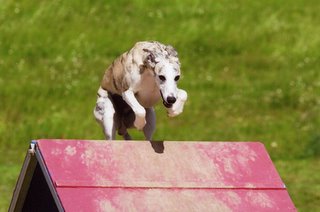By far the hardest challenge I have had with Wyatt is proofing. I had no idea initially that what we worked on at home could be so different somewhere else. So gradually and begrudgingly, I have deliberately added proofing to my training. gradually, Wyatt is getting more used to performing in busy, loud, places where there are many dogs around.
He is a very sensitive dog and somewhat timid and fearful. He is very quick to pick up on things though precision is not his strong suit. Patriot takes much longer to learn things but will come out looking perfect on things like fronts and finishes.
The role of stress and attention became very clear to me during one of our first CD attempts. I took him out to practice at the Big E's Mallory Arena. His performance was less than 50% of what I get at home. But I could see that he was looking around and very nervous. Of course, his attention was elsewhere!
This was not as clear to me in agility where things zoom by at a much faster pace. In agility, the stress manifests as contact issues and sometimes weave entries. Lately, we are doing better but standard runs can be hard since there are 3 contacts and 1 weave entry.
I worked for a long time on reducing his stress. We tried everything: anxiety wraps, different warm up rituals, rescue remedy, DAP spray, melotonin. I just did not find that it made that much of a difference. The one thing that did seem to help was walking him around the ring and grounds so we still do that.
Then I tried working on me: breathing, rescue remedy, visualizations. That helped some.
But now I am convinced that both dog and handler bring their own stresses into the ring. There have been times where I have been completely non-stressed at a run through and Wyatt has been really pumped. This happened recently when he saw a high energy German Shepard Dog running before him. For some reason, their energy gets him excited. So I don't buy the frequently heard notion that all stress comes from the owner.
So we are working through our stresses. I manage mine (or at least try to hide it from Wyatt). I do what I can to manage his. The biggest challenge is patience through all this and accepting my nature and my dog's nature. Wyatt may always be fast to learn but slow to earn titles.
It sure is an interesting journey. Enjoy the ride...

